Our gardening partnership installed a three-phase electric meter with a current transformer. The meter was new with all seals. However, when the load is completely switched off, the meter disk rotates slowly, that is, the meter is “self-propelled”. It is clear that the partnership did not want to pay for the energy recorded by the meter, which it did not actually use.
At first they decided that the meter was faulty. The meters were replaced several times, but the self-propelled gun remained. As a result, we came to a different conclusion - the meter is not to blame. We began to think what causes such a “self-propelled movement”? In the factory instructions included with three-phase meter, it is written: it is necessary to connect the meter to the network, observing the phase rotation sequence, so that phase A of the network is connected to the first terminal of the meter, phase B to the second, and phase C to the third terminal of the meter.
. |
The phase sequence can be easily established using a phase indicator. This is always available at power plants, in electrical facilities of large factories, but where would it be in gardening societies? Our attempt to rent a phase indicator for a couple of days from a large institution was unsuccessful. We had to make our own “Device for determining the phase sequence”, with the help of which it was possible to determine this correct sequence. As a result, after eliminating the violation of the sequence of phase alternation, the “self-propelled” meter disappeared. Therefore, there was no longer any need to pay for energy unused by gardeners.
Device for determining the phase sequence in a three-phase network
So, the above-mentioned “Device for determining the phase sequence” is designed to determine the phase in which the voltage lags behind the voltage in the phase arbitrarily taken as the starting point. Knowledge of this lag is necessary for the correct connection to the network of devices in which the phase sequence must be observed, for example, three-phase four-wire (with zero) electricity meters.
The design of the device is quite simple (Fig. 1). On a base made of electrical insulating material, such as textolite, there are two wall-mounted electric sockets with conventional incandescent lighting lamps screwed into them, covered with transparent casings made from plastic containers for juices, water, etc. A capacitor and terminals for connecting wires are also fixed on the base.
Some terminals from the lamps and the capacitor are soldered (point O), the other ends of the wires are connected to terminals A, B and C (Fig. 2).
The principle of operation of the “Device for determining the phase sequence” is as follows. When connecting the “Device...” to three-phase network Due to the presence of a capacitor in each phase, the voltage changes, which leads to different incandescence of the lamps. (In our case, phase B is connected to the capacitor.) By the amount of incandescence (brightness of the lamps) it is judged whether the remaining phases (wires) belong to phase A or phase C.
Page 2 of 13
Three-phase system.
A three-phase EMF (voltage) system is understood as a set of three symmetrical emfs, the amplitudes of which are equal in value and shifted (the amplitude of each emf relative to the previous amplitude of the other emf) by the same phase angle. In Fig. 1d shows a diagram of the simplest synchronous generator three-phase current. Windings, in. which induced alternating emfs are placed in stator slots, offset circumferentially by 120°. The terminals of the windings are assigned the designations “beginnings” of the ABS “ends” X, Y, Z, respectively. Passes along the rotor winding D.C., creating a magnetic field. When crossing the stator windings magnetic field of the rotating rotor, a symmetrical system of three sinusoidal EMFs of the same frequency and amplitude, shifted in phase by 120°, is induced in them (Fig. 1.6). For one revolution of the rotor, which corresponds to the time period T, a full cycle of EMF changes occurs in each of the windings. When the rotor axis /- / intersects the turns of the stator winding, maximum EMF is induced in them. But since for the three stator windings this happens at different times, the maximums of the induced EMF are not in phase, i.e. their amplitudes Ed, Eg, E are shifted relative to each other by 1/3 of the period, or 120° .
Phase. The angle characterizing a certain stage of a periodically changing parameter (in this case, EMF) is called the phase angle or simple phase. When considering together two (or more) sinusoidally varying EMFs of the same frequency, if their zero (or amplitude) values do not occur simultaneously, they are said to be phase shifted. The shift is always determined between identical phases, for example between the beginnings of sinusoids, as shown in Fig. 1.6, or between amplitudes. When two sinusoids are shifted in phase, one of them will lag behind the other in time. To determine which of the sinusoids is lagging, their origins are found, i.e., zero values of the EMF during the transition from negative 6 values to positive ones.
Rice. 1. Obtaining a three-phase symmetrical EMF system: 1 - stator; 2 - stator winding; 3 - rotor; 4 - rotor winding
In Fig. 1.6 beginnings are designated by the letters a, b, c. The figure shows that the beginning of one sinusoid (for example, the sinusoid passing through point b) is located to the right of the beginning of another (sinusoid passing through point a). This indicates that the sinusoid with the beginning at point b lags in time from the sinusoid with the beginning at point a. The sinusoid passing through point c lags even more behind, since its beginning is shifted by (2/3) T or 240° from the beginning coordinates (the moment when / = 0). We can equally say that a sinusoid with a beginning at point a is ahead of a sinusoid with a beginning at point b by (1/3) Tvi with a beginning at point c by (2/3) T.
In practice, a phase of a three-phase system is also understood as a separate section three-phase circuit, through which the same current passes, shifted relative to the other two in phase. Based on this, the winding of a generator, transformer, motor, or wire of a three-phase line is called a phase in order to emphasize that they belong to a specific section of the three-phase circuit.
Phases are designated by capital letters A, B, C. But it is not always convenient to hang letter inscriptions on the equipment of stations and substations. Therefore, when painting equipment (for example, busbars and connecting busbars in closed switchgear), which is used for corrosion protection, dyes of different colors are used. The paint is applied along the entire length of the tires.
Phase A tires are painted yellow, phase B tires are green, and phase C tires are painted red. Therefore, the phases are often called Zh, 3, K. To recognize the phases of equipment, corresponding colored marks in the form of circles or stripes are applied to casings, insulator fittings, structures and supports.
Thus, depending on the issue under consideration, a phase is either an angle characterizing the state of a sinusoidally varying quantity at each moment of time, or a section of a three-phase circuit, i.e., a single-phase circuit that is part of a three-phase circuit.
The order of the phases. The order in which the EMF in the phase windings of the generator pass through the same values (for example, through positive amplitude values) is called the phase order. Three-phase EMF systems may differ from each other in the order of the phases. If the generator rotor rotates in the direction shown in Fig. 1,c, then the phases will follow in the order A, B, C - this is the so-called direct order of the phases. If the direction of rotation of the rotor is reversed, the order of the phases will also change. The phases will pass through the maximum values in the order A, C, B - this is the reverse order of the phases.
Sometimes instead of the term “phase sequence” they say “phase sequence”. To avoid confusion, we agree to use the term “Phase Alternation” only when it is related to the concept of a phase as a section of a three-phase circuit.
Phase rotation.
So, by phase alternation we mean the order in which the phases of a three-phase circuit (individual line wires, windings and terminals of an electrical machine, etc.) are located in space, if you start bypassing them each time from the same point (point) and carry out in the same direction, for example, from top to bottom, clockwise, etc. Based on this definition, they talk about alternating designations for the terminals of electrical machines and transformers, the colors of wires and busbars. In some cases, the order of phase alternation is strictly regulated. Thus, the order of alternating designations of the terminals of synchronous machines is taken to correspond to the order of phases for the established direction of rotation of the rotor. The rules for the construction of electrical installations (PUE) provide for closed switchgears the following order of alternation of painted busbars when they are located in a vertical plane: the top bus is yellow, the middle is green, the bottom is red. When the tires are located in a horizontal plane, the most distant tire is painted yellow, and the one closest to the service corridor is painted red. Branches from the busbars are made so that phase G is located on the left, phase K is on the right, if you look at the busbars from the service corridor (with three corridors in the switchgear, from the central one).
At open substations, the alternating colors of busbars and bypass busbars are oriented according to the power transformers. The tire phase closest to them is painted yellow, the middle phase is green, and the distant phase is red. Branches from the busbars are made in such a way that the bus of phase G is located on the left, and phase K on the right, when looking at the transformer from the side of the busbars.
Deviations from the above requirements for the order of alternating painting of RU PUE busbars are allowed as an exception in those individual cases when compliance with these requirements is associated with the complexity of installation or the need to install special supports for the transposition of overhead line wires.
Phase coincidence. When phasing three-phase circuits, there can be various options for alternating the designations (colors) of the inputs on the switching device and supplying voltages of different phases to these inputs. For simplicity of further reasoning, let us assume that the phasing voltages of two electrical installation bus systems have the same phase order A, B, C and Ax, Bi, C|. Under this condition, the phases of the same voltages may coincide, and the order of alternation of input designations at the switch may not coincide (Fig. 2, a) or, conversely, with the same order of alternating input designations, the phased voltages may be shifted in phase (Fig. 2 , b). The rotation of stress vectors of the same name relative to each other can be not only at an angle of 120°, as shown in Fig. 2.6, but at any angle divisible by 30e, which is typical for transformers with different winding connection groups. In both of these cases, turning on the switch inevitably leads to a short circuit.
At the same time, a variant is possible when both coincide (Fig. 2, c) - Short circuit between the connected parts of the installation is excluded here.
By phase coincidence during phasing we mean precisely this case, when at the switch inputs located opposite each other and belonging to the same phase, the like voltages of the two parts of the installation coincide in phase, and the designations (colors) of the switch inputs are coordinated with the corresponding voltage phases and have the same alternation order.
Vector image of sinusoidally varying EMF (voltages, currents). Periodically changing sinusoidal quantities are depicted as sinusoids (Fig. 1.6) and rotating vectors - directed segments of a straight line (Fig. 1c). 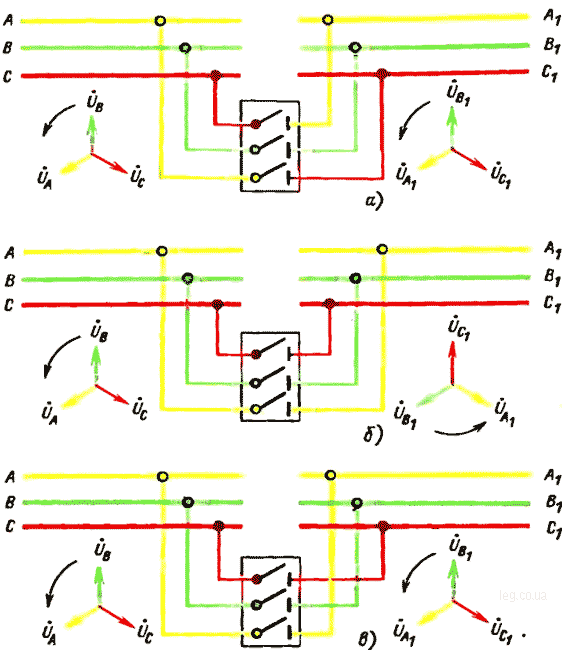
Rice. 2. Options for mismatch (f. b) and coincidence (c) of phases of two parts of the electrical installation
For phase EMF vectors Ej4, Eg. Eq> shown in this figure, the directions are conventionally taken from the beginnings of the windings to their ends. The relationship between the sine curve and the rotating vectors is shown in Fig. 3. A sinusoid is obtained by projecting a rotating vector (equal on a given scale to the amplitude of the changing EMF) onto the vertical axis /-/, moved along the abscissa axis at a speed proportional to the frequency of rotation of the vector. The phase shift between two vectors, the beginnings of which are combined at one point, is determined by the angle V (Fig. 4). The lag of vector Eg from vector Ed is shown by the direction of the angle arrow (against the direction of rotation of the vectors).
It should be said that the concept of a rotating vector of EMF (voltage, current, etc.) in electrical engineering is somewhat different from the concept of a vector, say, force or speed in mechanics. 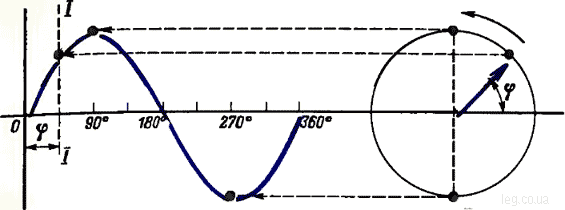
Rice. 3. Obtaining a sinusoidal graph when rotating a vector 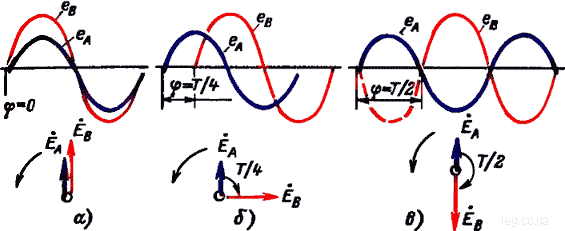
Rice. 4. Image of two EMFs with sinusoids and vectors at different shear angles
If in mechanics vectors cannot be completely determined only by their values without indicating the direction of their action in space, then in electrical engineering rotating vectors do not determine the actual direction of the quantities they represent in space. However, the total arrangement of vectors rotating at the same frequency (for example, the EMF of three phases) on the diagram gives an idea of what is happening in electrical circuit process over time and allows you to make a quantitative assessment of phenomena by performing elementary operations on vectors.
Basic connection diagrams for three-phase circuits.
The windings of electrical machines (generators, synchronous compensators, motors) and transformers are connected in a star or triangle.
When connecting three generator windings into a star, their ends are combined into one point (Fig. 5, c), which is called zero (or neutral). Electromotive forces between the beginnings and the zero point of the windings is called phase EMF and is designated Ed, Eg, Ee, or simply £ph. The electromotive forces between the phase terminals are called linear tn. They are obtained as the difference between the vectors of the corresponding phase EMF of the generator, for example Ed - Eg = Edd (Fig. 5,c). 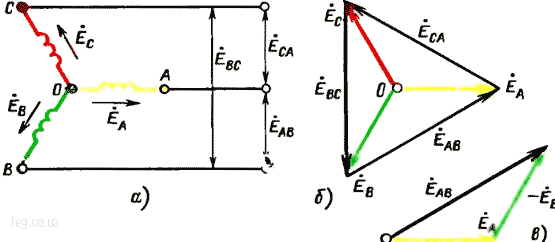
Rice. 5. Connection of generator windings in a star (o), vector diagram of EMF (b), subtraction of phase EMF vectors (c) 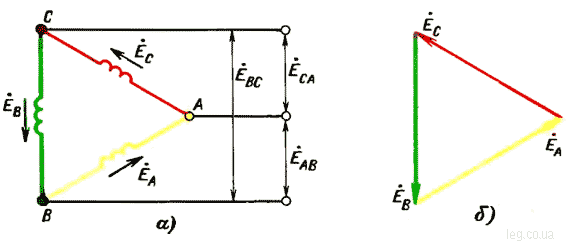
Rice. 6. Connection of the generator windings with a triangle (e) and vector diagram of the EMF (b)
The order of the indices in the designation of linear EMF is not arbitrary - the indices are placed in order
subtraction of vectors: Ev-Ec = Evc\ Ec-El = ESA- Taking into account the given direction of rotation of the vectors, this arrangement of indices corresponds to the subtraction of the EMF vector of the lagging phase from the EMF vector of the leading one. As a result, the linear EMF vectors are always ahead of the decreasing phase vectors by 30°. The values of linear EMF are \D or 1.73 times greater than phase ones, which is easy to verify by measuring the vectors on the diagram.
The connection of the generator windings with a triangle is shown in Fig. 6, o. Points A, B, C are common to each pair of phase windings. If there is no load connected to the generator terminals, then in the windings forming a closed circuit there is no current caused by sinusoidal EMF of industrial frequency, shifted relative to each other by (1/3) T, since at each moment of time the geometric sum of the EMF acting in the circuit triangle is equal to zero. You can verify this by examining the vector diagram in Fig. 6, b and the sinusoid of instantaneous EMF values of a three-phase generator (Fig. 1, b). 
Rice. 7. Change by 180° in the phase of the induced EMF when changing the terminal designations:
a - the phases of the EMF Ed and Ea coincide; b - EMF Ed and Eg are in antiphase
From Fig. 6, a it can be seen that when connected by a triangle, the linear wires extend directly from the beginning and end of the winding of each phase, therefore the phase EMFs are equal to the linear ones and coincide with them in phase. Note that at stations the windings of generators are usually connected in a star. The delta connection is extremely rare and only in turbogenerators of one type (TVS-30).
The windings of transformers, as well as generators, are connected in a star and triangle (a zigzag pattern is rare). The star circuit is often made with the zero point exposed. Schemes of connections in a star, in a star with a derived zero point and in a triangle in the text are usually designated by the letters U, Un and D, respectively. Windings high voltage(HV) transformers are connected in U or D, regardless of the connection diagram of the power sources. The secondary windings of medium (MV) and low voltage (LV) are also connected in U or D.
Unlike generators, powerful transformers have a common triangle connection of at least one of its windings,"de":["A5AYhSnfB-k"],"es":["7C9fiu0npMI","ojEyNl3xtSY","FQF7ctUIcFM","a -UI_yW8M2s","H2Qm6RPOUdM","k4X1PkHMjBs"],"pt":["-oChuiWH4e0","sDVn6RDFuek","yO0rcKtDqvA","-oChuiWH4e0","-oChuiWH4e0","ettHn5GRbgI","yO0rcKtDqvA"," ChZq1whXlyM","kW92XahgvW8","-oChuiWH4e0","mG05wQqNM0I","yO0rcKtDqvA","UH0m8o5nBWc"],"fr":["eWY6_9lzimM"],"it":["GObdG4YB4bE"],"bg":[ "T5fOAwhswBY","d8psjznn3fM"],"ro":["tQZdcmgosr0","tQZdcmgosr0"],"lt":["NabmU4r0Ojk"],"el":["6X2d4gC-eTs"])